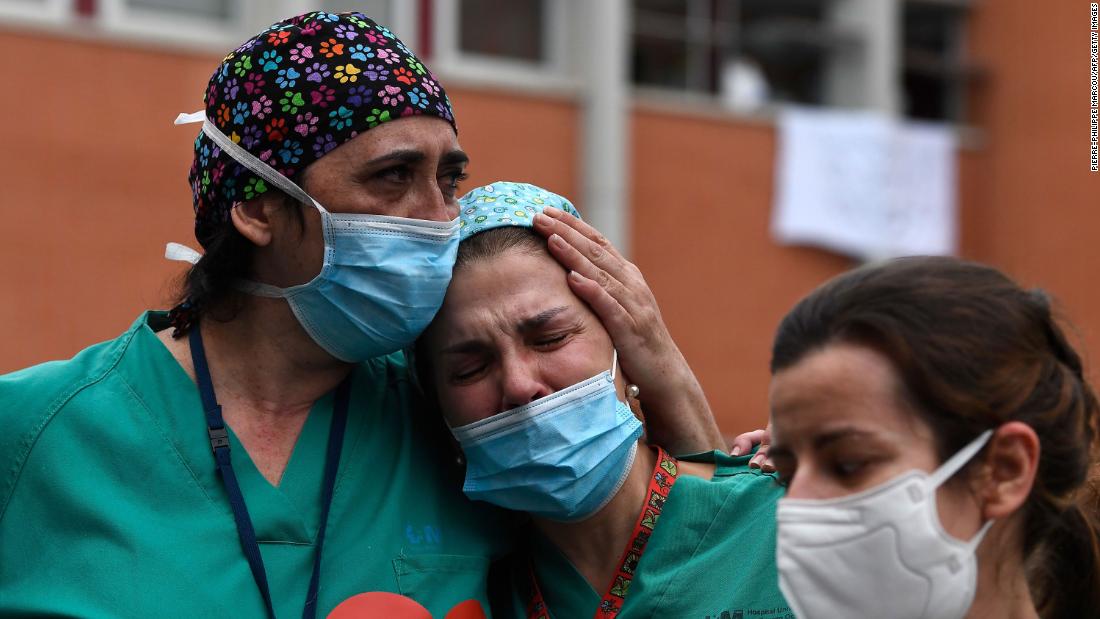The Global Pandemic Million Death Toll
"Our world has reached an agonizing milestone.""It's a mind-numbing figure. Yet we must never lose sight of each and every individual life.""They were fathers and mothers, wives and husbands, brothers and sisters, friends and colleagues."UN Secretary-General Antonio Guterres"So many people have lost so many people and haven't had the chance to say goodbye.""Many, many of the people who died, died alone in medical circumstances where it's a terribly difficult and lonely death."Margaret Harris, spokeswoman, World Health Organization"[The] unrecorded [death toll is much higher than a million.]""We must not forget that this pandemic is still accelerating and shows no signs of slowing down.""We must do everything in our power to bring this pandemic, and all its harmful consequences, to an end as quickly as possible."Jeremy Farrar, director, Wellcome Trust global health charity
 |
| In this Sept. 10, 2020, file photo, a woman wearing white protective gear, foreground, mourns after taking a glimpse of her husband's body, a victim of COVID 19, at a cremation site in Gauhati, India. (AP Photo/Anupam Nath) |
Around the world over 5,400 people die every 24 hours, according to calculations based on September averages. In other words, roughly 226 people every hour, or one person each 15 seconds that go by, dies of the virus that causes COVID-19. The death toll globally has now surpassed a million. A pandemic that has seen the global economy devastated, that has caused national health systems to falter and fail, and that has transformed life from what was seen as 'normal' to completely other.
No other event in recent history has had the magnitude of effect of this coronavirus that arose in China and in an excess of speedy transmission, engulfed the entire world. The first wave that struck most of the world from March to April, after its initial appearance in late December 2019 in Hunan, China, subsided in most countries it has plagued which took immediate shutdown action to reduce the prevalence of human contact in an effort to control the infection rate. That partial success in reducing infections motivated governments to restore a semblance of normalcy.
 |
| Relatives wearing personal protective equipment offer funeral prayers for a woman who died from the coronavirus, during her burial at a graveyard in Srinagar on May 21, 2020. |
Populations, fed up with social isolation, relaxed their inhibitions and fear of contagion as life began returning as close to ordinarily normal as possible while a measure of vigilance was maintained, has led to a creeping return of case numbers that began to accelerate wildly, leading to the dreaded 'second wave' and predictions of more and worse to come. All the while, medical science is frantically searching for a vaccine to establish herd immunity, even as public suspicion grows alongside a backlash against medical and government authority.
Lockdown measures and social isolation are being contested and challenged, and everywhere loud and angry protests take place. Those advocating for lockdowns in the hope of sparing the lives of the elderly and the health-impaired in an effort to control the SARS-CoV-2 virus, knock up hard against those championing sustained politically sensitive economic growth. The damage both to human life and the economy of nations varies, sometimes mysteriously, from country to country. Science desperately looks for answers to the questions surrounding this complex and mysterious disease.
 |
| Medical personnel move a deceased patient to a refrigerated truck serving as a makeshift morgue at Brooklyn Hospital Center on April 9, 2020 in New York City. |
Ironically, the most advanced country of the world economically, technologically, is the one representing the poorest challenge to the strategies involved in controlling the COVID epidemic. Deaths in the United States stand at over 205,000 and cases at a staggering 7.18 million, while India records the highest daily growth case rate in infections in the world; an average of 87,500 new cases daily, since the start of September. India, should its infection rate continue, will soon overtake the U.S. Both countries are loosening their lockdowns even in the face of escalating case loads.
Close to 25 percent of deaths have taken place in Europe where the World Health Organization warns of a concerning trend in western Europe, spreading the disease, mere weeks from the winter flu season. Major control interventions, warns the WHO, are required to stem the rising cases in Latin America where normal life has resumed in many of the afflicted countries. Asia, on the other hand, the first region the pandemic struck, experiences a lull, past its emergence from its second wave.
In Israel the Muslim custom of washing bodies of the deceased is no longer permitted; corpses wrapped now in plastic rather than the traditional cloth shrouds. Shiva, where in the Jewish religious tradition, people attend the homes of mourning relatives for seven days, has been suspended. Catholics in Italy are now buried without traditional funerals much less a priestly blessing. Former militiamen in Iraq pick up shovels now to dig graves, conducting both Christian and Muslim burials.
New burial sites have had to be opened as cemeteries are no longer able to accept more bodies for burial in the United States, Indonesia, Bolivia, South Africa and Yemen, where not much else unifies those disparate countries, during this historical time of COVID.
 |
| Healthcare workers mourn in memory of their co-worker Esteban, a male nurse who died of the coronavirus disease at the Severo Ochoa Hospital in Leganes, near Madrid, on April 10, 2020. |
Labels: Death Toll, Global Pandemic

<< Home